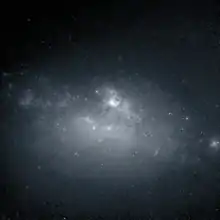 | |
| Object type | Galaxy |
|---|---|
| Other designations | Mrk 35, UGC 05860, HARO 03, SBS 1042+562, PGC 32103, MCG 9-18-22, IRAS 10422+5613, CGCG 267-9, ZWG 267.9 |
Observation data (Epoch J2000.0) | |
| Constellation | Ursa Major |
| 10h45m | |
| Declination | +55°57' |
| Redshift | 0.003 |
| Distance | 16.0 Mpc (52,000,000 ly) |
| 12.79 ±0.13, 12.9 ±0.13, 13.25 ±0.13, 11.381 ±0.025, 10.712 ±0.033, 10.613 ±0.046, 14.098 ±0.003, 13.249 ±0.002, 12.897 ±0.002, 12.849 ±0.002, 12.731 ±0.003 | |
| -18.53 | |
NGC 3353 (also designated as Mrk 35, UGC 05860, CGCG 267-9, HARO 03, ZWG 267.9 and etc[1][2]) is a type intermediate spiral (SABb) galaxy located 62.9 million light years away from earth in the constellation of Ursa Major.[3] NGC 3353 was discovered on March 18, 1790, by William Herschel,[4] a German born British astronomer.[5]
References
- ↑ "By Name | NASA/IPAC Extragalactic Database". ned.ipac.caltech.edu. Retrieved October 27, 2023.
- ↑ "Revised NGC Data for NGC 3353". spider.seds.org. Retrieved October 27, 2023.
- ↑ Ford, Dominic. "NGC3353 (Galaxy)". In-The-Sky.org. Retrieved October 27, 2023.
- ↑ "New General Catalog Objects: NGC 3350 - 3399". cseligman.com. Retrieved October 27, 2023.
- ↑ "William Herschel | Biography, Education, Telescopes, & Facts | Britannica". www.britannica.com. Retrieved October 27, 2023.
This article is issued from Wikipedia. The text is licensed under Creative Commons - Attribution - Sharealike. Additional terms may apply for the media files.